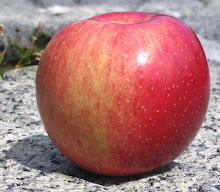 |
Today's medium-sized breed wears a light red jacket, somewhat translucent, over light green. The apple is round with such slight ribbing that I can realy only find it by running my fingers over the surface.
The sparse, large lenticels visible in the photo are an eye-catching accent, the more so since they are only on the top hemisphere of the fruit, but this variety has many smaller dots lower down. It smells very faintly of cider.
Freedom's flesh is a gently crisp creamy yellow, between fine-grained and coarse, and juicy. While still good, my sample is, in fact, on its way to mealy.
The flavor is mild with floral notes, caramel, and a little spice, reasonably well balanced between sweet and tart. There is a quick fleeting tart accent about halfway into each bite, and the peel dominates the finish.
The name of this apple promises freedom, in this case, to the grower, and from the risk of crop-ruining disease and the need for fungicides and bactericides.Freedom was specifically bred as a disease-resistant variety at Cornell University's New York State Agricultural Experiment Station, Geneva (New York).
The published account of that project conveys the patient scale of time involved in breeding a new strain. Robert Lamb gave Freedom life in 1958 when he first crossed two varieties then growing at Geneva.
Those seeds were planted and their fruit tested against an apocalypse of diseases, first at Cornell and, beginning in the 1970s, elsewhere.
Only in 1983 did the originators apply for a patent and make Freedom available to all comers.

Comments
Post a Comment
Join the conversation! We'd love to know what you think.